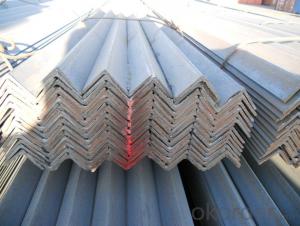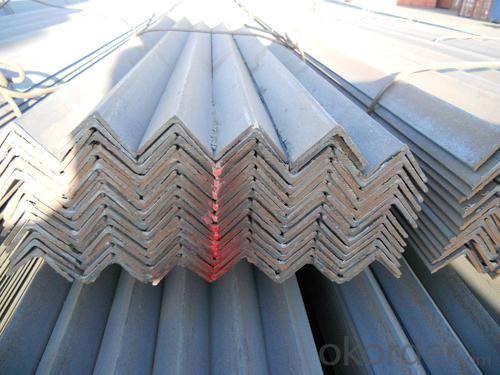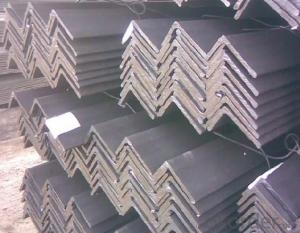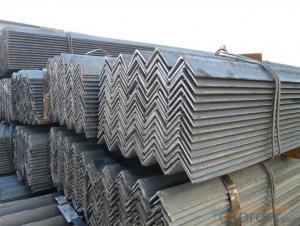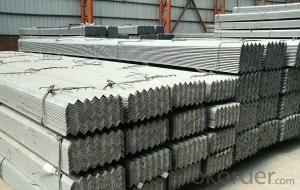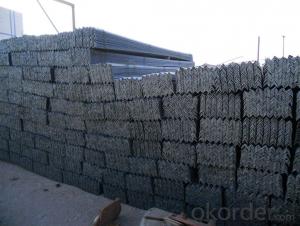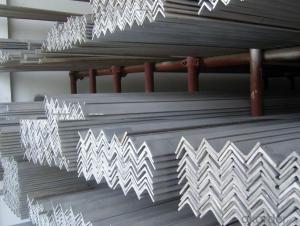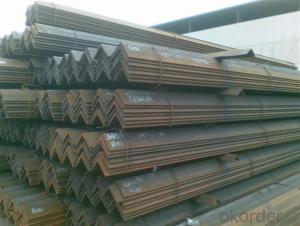GB Q345 Steel Angle with High Quality 65*65mm
- Loading Port:
- Tianjin
- Payment Terms:
- TT or LC
- Min Order Qty:
- 25 m.t
- Supply Capability:
- 10000 m.t/month
OKorder Service Pledge
OKorder Financial Service
You Might Also Like
Specifications of GB Q345 Steel Angle with High Quality 65*65mm:
1.Standards: GB
2.Material: Q345 or Equivalent
3.Length: 6m, 12m
4.Size:
| Size (mm) | Mass (kg/m) | Size (mm) | Mass (kg/m) |
| 65*65*5 | 4.907 | 65*65*8 | 7.662 |
| 65*65*6 | 5.841 |
Usage & Applications of GB Q345 Steel Angle with High Quality 65*65mm:
Trusses;
Transmission towers;
Telecommunication towers;
Bracing for general structures;
Stiffeners in structural use.
Packaging & Delivery of GB Q345 Steel Angle with High Quality 65*65mm:
1. Transportation: the goods are delivered by truck from mill to loading port, the maximum quantity can be loaded is around 40MTs by each truck. If the order quantity cannot reach the full truck loaded, the transportation cost per ton will be little higher than full load.
2. With bundles and load in 20 feet/40 feet container, or by bulk cargo, also we could do as customer's request.
3. Marks:
Color mark: There will be color marking on both end of the bundle for the cargo delivered by bulk vessel. That makes it easily to distinguish at the destination port.
Tag mark: There will be tag mark tied up on the bundles. The information usually including supplier logo and name, product name, made in China, shipping marks and other information request by the customer.
If loading by container the marking is not needed, but we will prepare it as customers' request.
FAQ:
Q1: Why buy Materials & Equipment from OKorder.com?
A1: All products offered byOKorder.com are carefully selected from China's most reliable manufacturing enterprises. Through its ISO certifications, OKorder.com adheres to the highest standards and a commitment to supply chain safety and customer satisfaction.
Q2: How do we guarantee the quality of our products?
A2: We have established an advanced quality management system which conducts strict quality tests at every step, from raw materials to the final product. At the same time, we provide extensive follow-up service assurances as required.
Q3: How soon can we receive the product after purchase?
A3: Within three days of placing an order, we will arrange production. The shipping date is dependent upon the quatity, how many sizes you want and the plan of production, but is typically 30 to 45 days from the beginning of production.
Images of GB Q345 Steel Angle with High Quality 65*65mm:
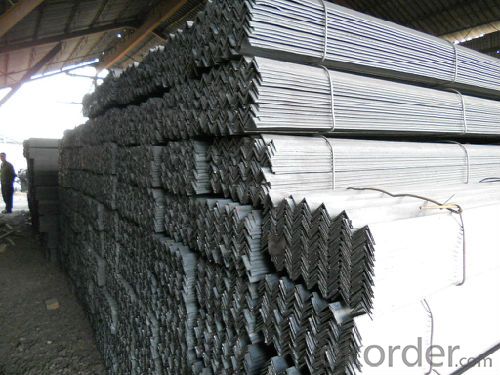
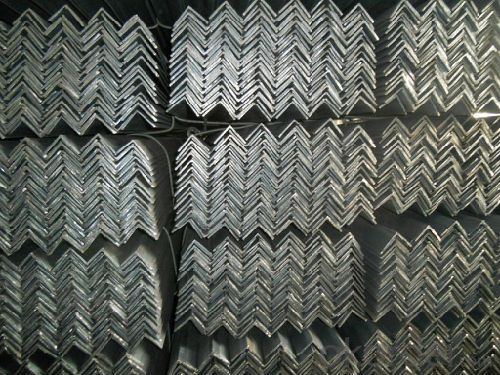
*If you would like to get our price, please inform us the size, standard/material and quantity. Thank you very much for your attention.
- Q: How do you cut steel angles?
- To cut steel angles, there are several methods you can use depending on the thickness and size of the angle. One common method is to use a metal cutting saw, such as a metal chop saw or a band saw. These saws are specifically designed to cut through metal and have the power and cutting capacity to handle steel angles. Before cutting, it is important to secure the steel angle firmly in place using clamps or a vice to prevent any movement during the cutting process. This will ensure accurate and clean cuts. It is also recommended to wear appropriate safety gear, including safety glasses and gloves, as cutting steel can produce sharp metal chips. If using a metal chop saw, you can adjust the angle on the saw to match the angle you need to cut. Make sure to set the blade speed and feed rate according to the manufacturer's recommendations for cutting steel. Slowly lower the blade onto the steel angle, applying steady pressure to achieve a smooth and precise cut. If a band saw is being used, ensure that the appropriate blade for cutting metal is installed. Adjust the blade tension and guide settings according to the manufacturer's instructions. Slowly feed the steel angle into the saw, maintaining a steady pace to achieve a clean cut. It is important to note that band saws may produce more heat during cutting, so periodically applying a coolant lubricant can help prevent overheating and extend the life of the blade. For thicker and larger steel angles, plasma cutting or oxy-fuel cutting methods can be utilized. These methods involve using high-temperature flames or a plasma arc to melt through the steel. However, they require specialized equipment and expertise to operate safely. Regardless of the cutting method used, it is crucial to measure and mark the desired cut line accurately before starting the cutting process. This will ensure that the steel angle is cut to the correct dimensions. Additionally, it is recommended to practice on scrap pieces of steel before attempting to cut the actual steel angle to gain familiarity with the cutting process and achieve the desired results.
- Q: Are steel angles suitable for manufacturing support brackets for cables?
- Yes, steel angles are suitable for manufacturing support brackets for cables. Steel angles provide strength and durability, making them an ideal choice for supporting and securing cables in various applications. They offer stability and can be easily customized and fabricated to meet specific requirements, ensuring reliable support for cable systems.
- Q: What is the minimum thickness of a steel angle?
- The minimum thickness of a steel angle typically depends on the specific application and the structural requirements. However, it is generally recommended to have a minimum thickness of around 1/8 inch (3.175 mm) for standard steel angles.
- Q: How do you maintain and clean steel angles?
- To maintain and clean steel angles, there are a few simple steps you can follow. First, it is important to regularly inspect the angles for any signs of damage or corrosion. If any issues are identified, they should be addressed promptly to prevent further damage. To clean steel angles, start by removing any loose dirt or debris using a soft brush or cloth. This will help prevent scratching the surface. Next, you can use a mild detergent or soap mixed with warm water to clean the angles. Apply the solution using a sponge or cloth, and gently scrub the surface. Avoid using abrasive cleaners or scrub brushes, as they can damage the steel. After cleaning, rinse the angles thoroughly with clean water to remove any soap residue. Make sure to dry the angles completely to prevent water spots or rust formation. You can use a clean cloth or towel for drying, or allow them to air dry. To maintain the steel angles, it is advisable to apply a protective coating or wax. This will help prevent corrosion and maintain their appearance. There are various types of protective coatings available, such as clear lacquers or metal-specific coatings. Follow the manufacturer's instructions for application and reapplication as needed. Additionally, it is important to avoid exposing steel angles to harsh chemicals or environments that can accelerate corrosion. If the angles are located in an area with high humidity or saltwater exposure, regular maintenance and inspection become even more crucial. Overall, routine cleaning, inspection, and proper maintenance will help ensure the longevity and appearance of steel angles.
- Q: Can steel angles be used for manufacturing storage racks?
- Yes, steel angles can be used for manufacturing storage racks. Steel angles are strong and durable, making them suitable for supporting heavy loads in storage rack systems. Additionally, their shape allows for easy assembly and customization of storage rack designs.
- Q: What are steel angles?
- Construction and engineering projects often utilize steel angles, which are a type of steel structural shape. These angles are L-shaped beams with legs of either equal or unequal length, forming a 90-degree angle. Typically made from hot-rolled steel, they can be found in a variety of sizes and thicknesses. Steel angles offer versatility and have many uses. They are commonly employed as framing elements in buildings and bridges, providing necessary support and stability. In addition, they can serve as reinforcement in concrete structures or as brackets and supports for equipment and machinery. One of the significant advantages of steel angles is their strength and durability. They are designed to withstand heavy loads and maintain structural integrity. Furthermore, steel angles are resistant to corrosion, making them suitable for outdoor applications and environments with high levels of moisture or chemical exposure. Steel angles are available in different grades, each with its own mechanical properties and characteristics. This allows engineers and designers to select the most suitable angle for a given project's requirements. In conclusion, steel angles are crucial components in construction and engineering. They offer strength, stability, and versatility across a wide range of applications. Whether providing structural support or reinforcement, steel angles play a vital role in ensuring the integrity and safety of various structures.
- Q: How are steel angles protected against UV degradation?
- Steel angles are protected against UV degradation through the application of protective coatings, such as paint or galvanization. These coatings act as a barrier, preventing direct exposure to sunlight and thereby reducing the risk of UV degradation.
- Q: How do steel angles perform in corrosive or acidic environments?
- Steel angles perform well in corrosive or acidic environments, but their performance depends on the type of steel used and the specific conditions of the environment. Stainless steel angles, for example, are highly resistant to corrosion and can withstand exposure to acidic environments without significant degradation. They contain a high percentage of chromium, which forms a protective layer on the surface when exposed to oxygen, preventing further corrosion. However, carbon steel angles are more susceptible to corrosion in corrosive or acidic environments. They lack the same level of chromium content and protective layer, making them more prone to rusting and degradation when exposed to such conditions. In such cases, additional protective coatings or treatments, such as galvanization or painting, may be necessary to enhance their resistance to corrosion. Furthermore, the severity and concentration of the corrosive or acidic substances in the environment can also impact the performance of steel angles. High concentrations of acids or corrosive substances can accelerate the corrosion process, even for stainless steel angles. Therefore, it is crucial to carefully assess the specific environment and choose the appropriate steel material and protective measures accordingly to ensure optimal performance and longevity in corrosive or acidic environments.
- Q: What is the process of galvanizing steel angles?
- To protect steel angles from corrosion, the galvanizing process encompasses multiple steps. Initially, the angles undergo a thorough cleaning process to eliminate any dirt, oil, or rust on the surface. This is achieved through pickling, wherein the angles are immersed in a solution of acid, usually hydrochloric acid, to eliminate impurities. Subsequently, the cleaned steel angles are rinsed to eliminate any remaining acid and are then dried meticulously. This step is crucial to ensure proper adhesion of the zinc coating. Following the cleaning process, the steel angles are immersed in a bath containing molten zinc. This is known as hot-dip galvanizing, where the angles are completely submerged in the zinc bath. The temperature of the bath typically reaches around 840°F (449°C). While the steel angles are immersed in the zinc bath, a metallurgical reaction occurs between the molten zinc and the steel. Consequently, a layer of zinc-iron alloy is formed on the surface of the angles. This layer offers exceptional resistance against corrosion and acts as a barrier between the steel and the corrosive elements present in the environment. Once the angles have been fully immersed in the zinc bath, they are removed and allowed to cool. The cooling process solidifies the zinc coating and ensures its adherence to the steel angles. Finally, the galvanized steel angles undergo a comprehensive inspection to ensure quality control. This involves examining the thickness, uniformity, and adherence of the coating to the angles. Various tests and measurements are conducted to verify that the galvanized coating meets the required standards and specifications. Overall, the galvanizing process for steel angles involves cleaning, immersion in a molten zinc bath, cooling, and inspection. This process yields a robust and long-lasting protective coating on the steel angles, enhancing their resistance to corrosion and extending their lifespan.
- Q: What are the common loadings or forces that steel angles are designed to withstand?
- Steel angles are designed to withstand common loadings or forces such as axial compression, axial tension, bending, shear, and torsion.
Send your message to us
GB Q345 Steel Angle with High Quality 65*65mm
- Loading Port:
- Tianjin
- Payment Terms:
- TT or LC
- Min Order Qty:
- 25 m.t
- Supply Capability:
- 10000 m.t/month
OKorder Service Pledge
OKorder Financial Service
Similar products
Hot products
Hot Searches
Related keywords
